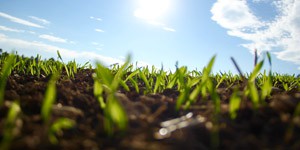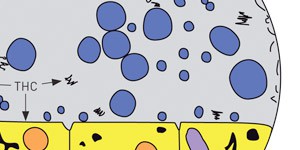By Guillermo Moreno-Sanz

Dr. Moreno-Sanz has authored more than 30 scientific articles and 3 patents describing the role of the endocannabinoid system in pain perception. Graduated in Biochemistry and Organic Chemistry from the University of Zaragoza, he obtained his PhD in Neuroscience from the Complutense University of Madrid, in Spain. He gained extensive international experience with long-term fellowships in the Netherlands, Italy, and the United States, developing most of his academic career at the University of California, Irvine, where he discovered a new class of cannabinoid analgesic with high clinical potential. In 2017, he acted as a consultant to the National Academies of Sciences of the United States in the preparation of the report "The health effects of cannabis and cannabinoids" and later founded Abagune Research to offer scientific advice and R&D solutions to the international cannabis industry. In 2020 he assumes the scientific and medical direction of Khiron Life Sciences in Europe.
Last March, the prestigious scientific journal Nature published the results of an investigation in which scientists from the University of California Berkeley described the production of phytocannabinoids, such as THC and CBD, in genetically modified yeast strains. This technical advance opens the door to the production of purified cannabinoids for the cosmetic, pharmaceutical and recreational industry without the need to grow and extract the cannabis plant. This option is being investigated by different companies and might cause an imbalance in the future cannabis industry. In this article we will try to unravel what this technique consists of and what are its advantages and limitations.
What is biosynthesis?

Figure 1. Synthetic pathways of THCA and CBDA
genetically included in yeasts endow these
microorganisms with the ability to produce
cannabinoids (from Luo et al., 2019).
Unlike chemical synthesis, which is carried out through controlled reactions inside a flask or reactor, biosynthesis is the formation of molecules inside a living organism. Normally, this process is carried out by specialized proteins called enzymes.
Each enzyme facilitates the conversion of one or more precursor molecules that react with each other called "substrates" into one or more new substances called "synthesis products" or "reaction products". It is common for enzymes to be called according to their substrate and the reaction they cause.
Enzymes are often associated by creating "reaction chains" or "synthesis routes", in which the product of one enzyme serves as a substrate for the next, thus forming authentic assembly lines that result in one or more complex molecules.
For example, this is the process by which the amino acid tyrosine serves as a precursor for the manufacture of dopamine and adrenaline, two neurotransmitters whose synthesis route begins with the conversion of tyrosine into L-DOPA facilitated by tyrosine hydroxylase.
What interest is biosynthesis in industrial processes?
Chemical synthesis allows us to generate new molecules that do not exist in nature through controlled chemical modifications. Some industries, such as petrochemicals, use this type of synthesis to generate their products. In the case of the production of compounds with a certain biological activity, there are some limitations for the chemical synthesis that biosynthesis can solve. The first example was the manufacture of penicillin, discovered by Alexander Fleming in 1928 in some species of fungi of the genus Penicillium. In the 40s, it was possible to optimize the conditions of manufacture of penicillin, cultivating these fungi in large fermenters, which managed to reduce the cost of production from $20 per dose in 1943 to 55 cents per dose in 1946. Due to the emergence of antibiotic resistance, other penicillin families were developed following two strategies: adding artificial precursors in the culture medium of the producing fungus, which leads to the obtaining of biosynthetic penicillins, and the chemical modification of the penicillin obtained by Biosynthetic fermentation, which results in semi-synthetic penicillins.
Another advantage of biosynthesis is stereoselectivity. Most complex molecules have chiral centers, which means that the same compound can exist in different three-dimensional conformations. Like a pair of gloves they seem identical, but in reality they are different. These different conformations, called stereoisomers, often have very different biological activities, with normally only one of them being active from a pharmacological point of view. A famous and fateful example is the case of thalidomide, the same molecule with two stereoisomers, one effective against nausea in the first trimester of pregnancy and another capable of causing malformations in foetuses. Since then, the isomerism factor in drug development is taken into account. Chemical synthesis, except in the case of stereoselective reactions in which a single stereoisomer spontaneously forms, usually produce different amounts of stereoisomers known as "racemic mixtures", forcing a subsequent purification of the active molecule. However, being facilitated by enzymes that restrict the spatial conformation of their substrates and orient them in a single direction, biosynthesis is capable of producing only the active isomer without the need for further purification.
When does the part of cloning microorganisms arrive?
Just now. The fungi of the genus Penicillium "manufacture" penicillin naturally because they are equipped with all the enzymes necessary to complete the "synthesis route". In the case of other biosynthetic compounds, first it is necessary to model through genetic engineering the microorganism that is going to be used for its "manufacture". There are several examples of bacteria, fungi and yeasts genetically modified for the production of drugs or precursors thereof. These microorganisms are called "recombinants", as their genome has been manipulated to include external DNA and provide them with the enzymes necessary for the transformation of simple substrates into complex products. One of the first examples was the production of insulin, a peptide produced by the pancreas that regulates blood sugar levels. Initially, the insulin used clinically by diabetic patients was obtained from pigs, as porcine and human insulin are practically the same, with the exception of a single amino acid.
However, insulin is currently produced in bioreactors by means of a common type of E. Coli bacteria, which has been genetically modified to produce it more comfortably and economically. In addition to E. coli, the most studied bacterium for biosynthesis purposes, baker's yeast, Saccharomyces Cerevisiae, has also been intensively researched for both its ability to store larger amounts of DNA than bacteria and doing so in a format more similar to that of animals. Recombinant versions of S. Cerevisiae have been developed for the production of the artemisinin antimalarial, discovered in the 70s by the Chinese Nobel Prize Youyou Tu. Artemisinin is usually extracted from the Artemisia annua plant but its agricultural production does not represent a stable source of the product, which is subject to large price fluctuations(Peplow, 2013).
Another example using S. Cerevisiae is the manufacture of morphine and other opiates from simple sugars. The synthesis route of opiates is relatively long with almost twenty steps. Different groups have published the successful cloning of parts of the yeast synthesis chain but it has not yet been possible to include it all in a single organism (Ehrenberg, 2015). This would be the first step toward the production by fermentation of opiates, whose origin at the moment is the opium poppy plant, of which the Spanish company Alcaliber is the second largest producer in the world.
And this has been achieved with cannabinoids?
Exactly. The UC Berkeley group has managed to include all the enzymatic machinery necessary to manufacture cannabinoids inside this yeast and successfully produce THCA and CBDA on a laboratory scale (Figure 1). Different parts of the synthesis chain had previously been cloned into other organisms such as tobacco roots or Pichia Pastoris, but this is the first time that manufacturing can be done from the fermentation of sugars without the need to add a precursor or reaction intermediate(Luo et al., 2019). However, there are still important technological challenges to be faced before achieving the optimisation of cannabinoid production by means of biotechnological fermentation, which is what sector leaders in terms of capital investment such as the American Amyris, Teewinot or Librede among others and the Canadian Cronos Group, InMed and Organigram are aiming to achieve.
What are the advantages and disadvantages of cannabinoid biosynthesis?
Considering the level of current technical development, we can make a forecast of what the consequences of the implementation of biosynthesis for the agricultural sector of the cannabis industry might be. Some important aspects to consider would be:
- Regulatory: Cannabis is a controlled substance and its cultivation, processing and sale is strictly regulated. The possibility of producing its active ingredients without resorting to plant cultivation would be an advantage from the legal point of view.
- Economic: Some companies are estimating the cost of cannabinoid production through these techniques at around 1000 dollars a kilo, between 4 and 5 times cheaper than outdoor cultivation, and about 30 times cheaper than conventional chemical synthesis. However, this aspect does not a guarantee a competitive advantage in the market as does the case of artemisinin mentioned above.
- Continuous production cycle: fermentation can be carried out continuously while traditional farming methods have production cycles of 3-4 months.
- Cannabinoid purification: the extraction and purification process would be theoretically simpler compared to the crop-harvested-cured-extraction-purification method that agricultural production involves.
- Purity and quality control: Easier to certify in order to meet pharmaceutical manufacturing specifications.
- Ability to synthesize non-abundant or structurally modified cannabinoids.
However, it must be taken into account that biosynthesis would have to overcome serious technical limitations in order to become a profitable manufacturing strategy and that achieving this continues to present some limitations with respect to agricultural production:
- The low water solubility of cannabinoids means that the process, which is carried out in an aqueous medium, may not achieve satisfactory production yields.
- Microorganisms capable of producing natural oils, such as algae, are more difficult to manipulate genetically and their use may require complex precursors such as cannabigerol (CBG).
- Biosynthesis focuses exclusively on obtaining purified cannabinoids for pharmaceutical purposes that are identical to those obtained from herbal cannabis. However, it does not allow the production of extracts rich in other components of the plant that are currently the most popular products in the recreational and medicinal market due to the potential interaction between the active molecules present in plant extracts that, acting synergistically, might theoretically improve the safety and efficacy profile of cannabinoids.
- Similarly, it does not replace the production of cannabis flowers, or herbal cannabis, which is still the preferred option for many recreational users and patients who resort to self-medication.
Bibliography
Ehrenberg, R., 2015. Engineered yeast paves way for home-brew heroin. Nature 521, 267–268. https://doi.org/10.1038/251267a
Luo, X., Reiter, M.A., d'Espaux, L., Wong, J., Denby, C.M., Lechner, A., Zhang, Y., Grzybowski, A.T., Harth, S., Lin, W., Lee, H., Yu, C., Shin, J., Deng, K., Benites, V.T., Wang, G., Baidoo, E.E.K., Chen, Y., Dev, I., Petzold, C.J., Keasling, J.D., 2019. Complete biosynthesis of cannabinoids and their unnatural analogues in yeast. Nature 567, 123–126. https://doi.org/10.1038/s41586-019-0978-9
Peplow, M., 2013. Malaria drug made in yeast causes market ferment. Nature 494, 160–161. https://doi.org/10.1038/494160a


